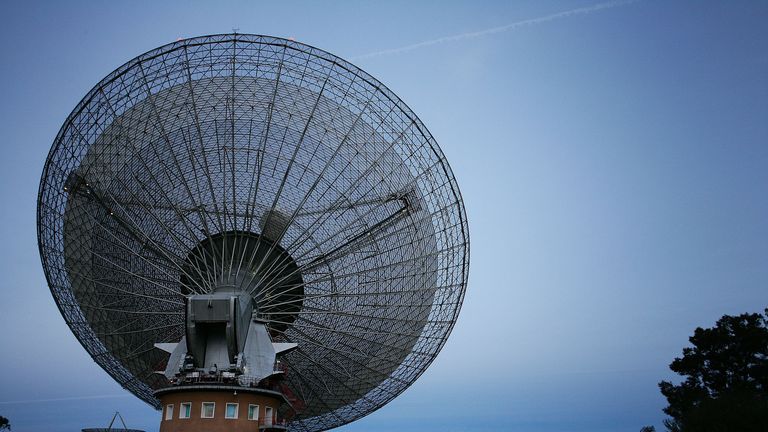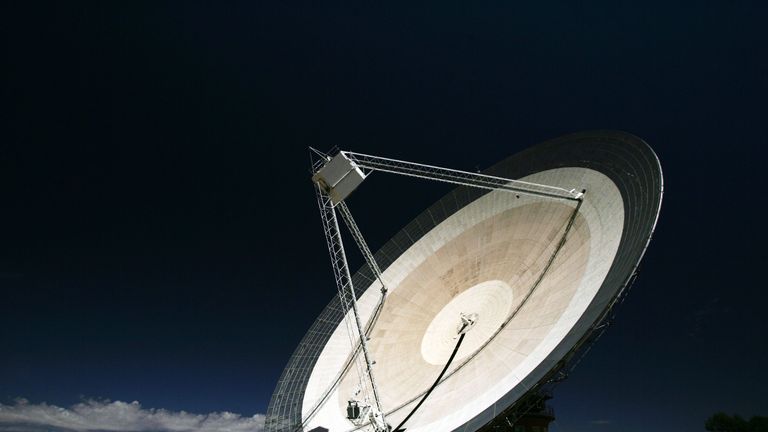The Dish town celebrates key role in moon landing broadcast
Parkes, in New South Wales, stepped in to provide the best images of the moon landing which were beamed around the world.
Saturday 20 July 2019 12:31, UK
The Australian town that saved the day to broadcast the moon landing live is celebrating its role in history.
Parkes Observatory, in New South Wales, was chosen as one of the three stations to beam back the vital live images from space as Neil Armstrong took the first steps on the moon 50 years ago.
The Dish, as it is affectionately known, ended up getting the best images, despite its unassuming position in the middle of a sheep paddock, and NASA stuck with its pictures as 600 million people tuned in around the world.
David Cooke, who was senior receiver engineer at the time, recounted his role in the day after they were called on to receive signals, alongside the Honeysuckle Creek tracking station outside Canberra, and NASA's Goldstone station in California.
He said he was mostly concerned about doing his job well that day and the enormity did not hit him until after the day was done.
Now 87, he said: "It was after we had finished tracking when I went down, outside the telescope, and looked up and saw the moon.
"It was then that it struck me that this was an amazing thing, that there was a man, two men up walking on the moon, and a third one there as well.
"Then I took a photo of the dish and the storm disappearing in the distance."
Recalling his feelings before the events, he said: "I knew what was going to happen and the whole world was waiting but I think I was like everyone else, we were trained to take part and we were concerned about doing our job properly so nothing would go wrong."
The images set one six-year-old boy on his path to think of astronomy, and eventually to a job at the same dish.
John Sarkissian, who is now the operations scientist at the dish, said: "I was in first class, a little school boy sitting cross-legged on the cold wooden floor of my school in Sydney and we were all watching it on television, in the little black and white TV screen that was on a pedestal in the front of the room. And my fellow classmates and I were totally mesmerised by what we were seeing.
"We didn't fully understand or appreciate what was happening at the time but in the years since then, thinking back to that event, I've come to realise that really it was the time that I started thinking about astronomy.
"And for people of my generation it was something that inspired them very much and at the time when watching the astronauts bounding around on the moon surface, I had no idea at the time that 50-something years later I'd be actually working at the place that received those television pictures."
Residents of Parkes remain proud of the role their town played in the moon landing five decades ago.
Emily McQuie, a 16-year-old student, said: "It's a bit hard to comprehend it sometimes because it's such a global event and to think Parkes played a part in that is so phenomenal."
Resident Alexandra Burke said: "Very proud, we love the dish. We grew up with the dish in our backyard and so when we were kids we would go out to the dish and everyone dreamt of becoming astronauts, or astrophysicists."
To commemorate the dish's vital role in the subsequent two and a half hour broadcast on 21 July 1969, the town is hosting events at the observatory including open days with tours and talks.
There is also a screening of the 2000 film The Dish, which told a slightly fictionalised version of the tale, with an introduction from Roy Billing who played the Mayor of Parkes.
On Sunday afternoon, the moon landing will be broadcast at the dish, as it happened 50 years ago.







